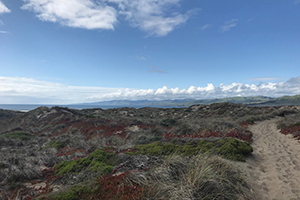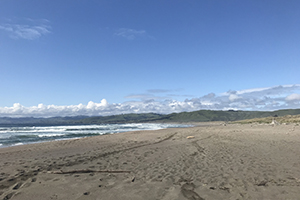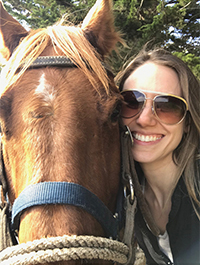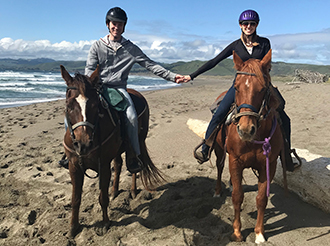My next adventure on horseback brought me to the coast of the Pacific Ocean on the shores of breathtaking Bodega Bay. Situated about 60 miles north of San Francisco, CA, Bodega Bay was the ancestral home for the Coast Miwok Native Americans.
After researching the history and culture of the Coast Miwok people, I learned that they were skilled hunters, fishers and gatherers who thrived off of the bounty nature provided them — clams, salmon, seaweed, rabbits, deer, roots, acorns and even grasshoppers. They used the Tule plant for their clothing, boats, round houses (kotcas) and renowned basketry and were known for tattooing and wearing ear and nose ornaments. The Coast Miwok also used seashells, especially the Washington clam shell, as a commodity in trade.

Riding on the beach has always been on my bucket list and to have this experience in a location that served as the lifeblood for the Coast Miwok was an extra special treat. (Plus, I got to ride with my husband this time!)

We crested the grass-covered sand dunes, and the bay opened up before us, revealing a stretch of shining sand gently lapped at by the breaking waves. Our horses’ hooves sunk deep into the damp sand as we picked up to a canter, sending the seagulls scuttering to safer ground.
The sun’s rays winked off the never-still water and brought a contented warmth to my soul. We begrudgingly turned our horses back to the dunes for one more exhilarating breakneck run that sent my heart pounding before walking the rest of the way back.
Like other California tribes, the arrival of explorers and occupiers deeply impacted the Coast Miwok, resulting in the loss of homelands, disease, mistreatment and enslavement. Read the Graton Rancheria community’s timeline of their people’s history from 1579 to the present here.
As the timeline recounts, through the termination era and gaining momentum in the 1990s, tribal members continued to protect their cultural identity and archaeologically important sites and worked for the restoration of their rights. In 2000, President Clinton signed into law legislation restoring federal recognition to the Federated Indians of Graton Rancheria, formerly known as the Federated Coast Miwok. Learn more about the rancheria on its website.
Tribal members created Kule Loklo (“Valley of the Bear”), a replica of a pre-European Coast Miwok village, in the 1970s. Located in Point Reyes National Seashore, Kule Loklo hosts the annual Big Time Festival in July where basketry, clamshell bead-making and traditional dancing are all demonstrated.
Unfortunately, my schedule didn’t allow me to also visit this time, but I hope to attend one day! Read more about this year’s event, to be held on Saturday, July 21, here.

(Editor’s note: This is Casey’s sixth segment in the “Hoof Beats” blog series, which describes her travels in Indian Country on horseback.)
References:
Books:
“Tiller’s Guide to Indian Country” by Veronica E. Velarde Tiller
Websites:
- http://www.kstrom.net/isk/art/basket/pomohist.html
- https://www.nps.gov/pore/learn/historyculture/people_coastmiwok.htm
- http://www.ptreyes.org/activities/kule-loklo-coast-miwok-cultural-exhibit
Read more:


